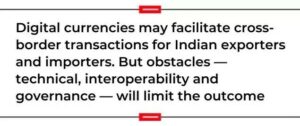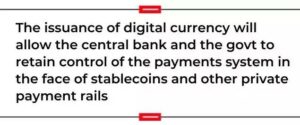Slow and steady is how India's digital currency will win
25 Dec 2022
Opinion: Barry Eichengreen & Poonam Gupta
India needs to adopt a cautious and informed approach to launching a full-fledged digital currency as the prevalent infrastructure may limit its potential benefits.
Finance minister Nirmala Sitharaman announced a commitment to issue a digital rupee in her Budget speech delivered on February 1, 2022. Although in the subsequent months, the RBI provided only limited clarity on how the digital currency would be developed or rolled out, it still went ahead and launched the pilot of its digital currency.
The pilot was launched in wholesale space (e₹-W) on November 1, 2022, with use of the currency limited to the settlement of secondary market transactions in government securities. This was followed a month later by the launch of the pilot in the retail segment (e₹-R), within a closed user group of customers and merchants.
Sundry other details have been disclosed, such as that the digital currency will be issued in the same denominations as the paper currency and is being distributed through participating banks.
 Users can transact through a digital wallet, and transactions can be both person-to-person and person-to-merchant. The digital currency will not earn interest, but it can be seamlessly converted into other forms of money, including bank deposits.
Users can transact through a digital wallet, and transactions can be both person-to-person and person-to-merchant. The digital currency will not earn interest, but it can be seamlessly converted into other forms of money, including bank deposits.
The advantages
India is relatively well-positioned to launch a digital currency: it has put in place an advanced digital payment system that works at scale; a majority of its population owns a cell phone, with a significant number among them owning a smart phone; access to the banking system is widespread, and a growing share of consumers are tech-savvy and proficient in conducting digital transactions.
Yet, the prevalent infrastructure also limits the potential benefits that can be derived from a digital currency.
The main argument in favour of a digital currency is that it is a safer, cheaper, and more convenient mode of payment than cash, cheques, debit cards and credit cards. A second argument is that it will promote wider financial inclusion. Both arguments are in fact dubious.
With the prevalence of a relatively efficient low-cost electronic payments infrastructure, India will reap only limited benefits in terms of convenience and cost. The country has already made unprecedented progress in achieving near- universal financial inclusion, limiting those benefits as well.
A more pertinent rationale in favour of digital currency is that its issuance will allow the central bank and the government to retain control of the payments system in the face of stablecoins and other private payment rails. The concern is that, if payments migrate away from UPI and toward a private-label stablecoin, the central bank will be left with limited insight into the operation of the payments system and limited ability to ensure its integrity. This will especially be the case if a single large private provider acquires dominating market power over payments and related services.
While a valid concern, a more straightforward solution to this problem would be simply to strengthen the regulation of private providers, including stablecoin issuers.

The challenges
Digital currencies may supposedly facilitate cross-border transactions, thereby simplifying things for Indian exporters and importers. But technical obstacles to interoperability and governance obstacles will limit achieving this outcome. Governance problems, in particular, may be formidable. The participating central banks would have to agree on an architecture for the corridor in which one central bank’s digital currency is exchanged for another. They would have to jointly govern its operation. They would have to license and regulate dealers holding inventories of currencies, and ensure that the exchange rate inside the corridor does not diverge significantly from that outside. They would have to agree on who would provide emergency liquidity, against what collateral, in the event of a major order imbalance. In a world of 180 currencies, arrangements of this type would require scores of bilateral agreements.
With so many central banks and governments around the world contemplating the issuance of a digital currency, it was inevitable that India would contemplate the possible development of its own digital currency, as deputy governor, RBI T Rabi Shankar mentioned in an event in April 2022, adding that “it was not a question of whether, but how to do it well.”
But India stills needs to adopt a cautious and informed approach to launching a full-fledged digital currency. It would be advisable to constitute expert groups to analyse the question and place their analyses and recommendations in the public domain. Those expert groups will need to assess the readiness of banks, other financial intermediaries, and the public to use digital currency, its impact on the conduct of monetary policy and its transmission, and implications for capital flows, the exchange rate, and the composition and management of foreign reserves.
In terms of equity, officials and outside experts need to pay close attention to the costs and benefits of a digital currency for population groups with different levels of literacy and differential access to digital hardware and Internet connectivity.
A popular mantra in the digital sphere is “move fast and break things.” In the case of an Indian digital currency, we would instead advise “slow but steady wins the race.”
Published in: The Times of India, 25 Dec 2022







 Users can transact through a digital wallet, and transactions can be both person-to-person and person-to-merchant. The digital currency will not earn interest, but it can be seamlessly converted into other forms of money, including bank deposits.
Users can transact through a digital wallet, and transactions can be both person-to-person and person-to-merchant. The digital currency will not earn interest, but it can be seamlessly converted into other forms of money, including bank deposits.